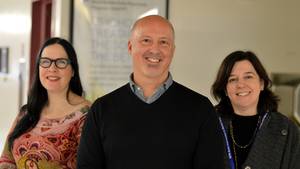If her rare, slowly progressive hormonal disorder had been diagnosed 20 years earlier, Janet Cameron knows she wouldn’t have lived with extremely large hands and feet for so long, or other painful medical conditions and their resulting surgeries.
Looking back, Janet started seeing symptoms of acromegaly — a hormonal disorder that develops when the pituitary gland produces too much growth hormone during adulthood — in 1974, after the birth of her child.
“It wasn’t something you could pinpoint,” says Janet, a retired intensive care unit nurse. “It was affecting my entire body.”
She had urinary issues for more than 20 years that led to painful kidney stones and she underwent a pyeloplasty — a reconstruction of the narrowed ureter, a tube that carries urine from the kidney to the bladder. There were also gradual changes in the shape of her face, including a protruding lower jaw and brow, a large tongue and a deep, husky voice.
Acromegaly usually causes the bones in the feet, hands and face to grow in adulthood. Janet blamed her big hands on her father’s side of the family; her ring size went from a seven to an 11 and her feet grew so big that she could only wear extra-wide men’s running shoes.
But it wasn’t until 2019, when she underwent emergency heart surgery at the QEII Health Sciences Centre to clear several blockages, that a doctor started piecing together her long, complicated medical history.
A blood test was ordered to check her growth hormone; the results led her immediately to the QEII’s endocrinology team. A tumour causing an excess amount of growth hormones in the pituitary gland area was discovered and removed by Dr. David Clarke, QEII neurosurgeon, in late January 2020.
“They saved my life,” says Janet.
Dr. Ali Imran, an endocrinologist at the QEII’s Halifax neuropituitary clinic, says that Janet is not alone. Patients with acromegaly typically start having symptoms 10 to 15 years before they are diagnosed.
“The changes that typically occur are slow and subtle but are still causing harm,” says Dr. Imran. “There are many out there who have the disease but don’t know it.”
The Halifax neuropituitary team, including Dr. Imran and Dr. Clarke, want to change that. Understanding that mass screening through blood tests is expensive, the team are developing other strategies for early diagnosis.
“The disease causes high morbidity,” says Dr. Imran. “The best approach is to diagnose the disease early on.”
Dr. Imran and his team, who see between three and five new patients with acromegaly each year and follow 100 patients with the disorder in Nova Scotia, previously developed a visual scale to help doctors assess changes to a patient’s facial features, to determine if the changes were early or advanced.
The team turned to Dr. Raza Abidi, a computer science professor at Dalhousie University and director of health informatics, to help develop patient-centred early diagnosis tools using artificial intelligence based facial recognition. A mobile app that patients can access on their mobile phones to detect changes to their facial features is now being developed.
“It could point to how the disease is actually progressing,” says Dr. Abidi. “Patients can regularly self-monitor their facial features to detect acromegaly-related abnormalities.”
Once fully developed, the mobile app will allow patients to take front and side images of their face. Those images would then be analyzed and compared with several previous facial images of the patient, along with images of other patients with the disease and those without the disease to detect changes to the patient’s facial features.
“It increases the accuracy of determining the level of the facial distortion,” says Dr. Abidi. “Now, to a large extent, we are taking out the subjectivity.”
Once the mobile app is fully developed and being used next year, Dr. Imran’s plan is to conduct a study on a larger population to test its efficacy in detecting cases of acromegaly earlier, to help prevent patients like Janet from developing medical conditions that can be caused by the disorder, such as coronary artery disease, sleep apnea and abnormal enlargement of certain organs.
“It will allow us to diagnose and treat more patients earlier,” says Dr. Imran.
For Janet, that is good news. She hopes others can be spared the years of suffering she endured. But instead of looking back, she is looking ahead to a healthier life now that her tumour is gone and her acromegaly has been diagnosed.
Having kept her sense of humour throughout her years of painful medical problems, she is appreciating the small, everyday things she now enjoys: daily, hour-long walks with her husband in Antigonish, climbing dozens of stairs and golfing nine holes.
“Getting rid of this tumour, I’m realizing how abnormal I was,” she says with a laugh.








